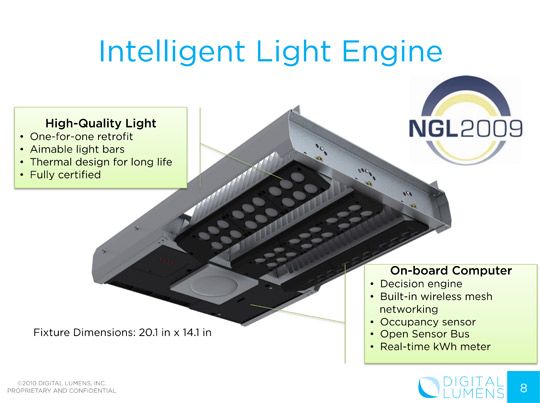Lighting remains the low-hanging fruit in energy efficiency efforts.
Lighting consumes 25 percent of the energy in commercial buildings and 12 percent in homes, according to the DOE's Buildings Energy Data Book for 2008. Seven percent of all the energy consumed in America is used to light our homes and our businesses.
Here's a link to a DOE report on the potential of energy savings with solid state lighting (SSL). It's a great report that covers markets, technology, and retrofits versus new builds and Color Rendering Index (CRI) issues.
Key findings from the report include:
- The cumulative SSL potential energy savings for 2010 to 2030 total approximately 1,488 terawatt-hours, representing $120 billion at today's energy prices.
- These savings would reduce greenhouse gas emissions by 246 million metric tons of carbon.
That's a lot of energy, money, and carbon to be saved with SSL.
SSL startup Digital Lumens is using the superior directionality and controllability of Light Emitting Diodes (LEDs) to save big money for industrial lighting applications. The Boston-based firm has raised over $11 million from Boston-based VCs Black Coral Capital, Flybridge Capital Partners and Stata Venture Partners, with a staff that includes members of recent SSL success and Philips acquisition, Color Kinetics.
The firm is combining LED fixtures, software and networking technology to tackle large, high-intensity lighting in high-bay industrial applications: warehouses, Target, etc.
I spoke with the CEO, Tom Pincince, and he said, "We deliver 100 percent or more light for 10% of the energy." Pincince said that their intelligent lighting systems can achieve "radical new levels of efficiency" and that for the "first time, customers can have real control of their lighting" to achieve that 90 percent reduction in energy.
The CEO also said that "the best thing about lighting is every niche is huge" in the $15 billion industrial lighting market.
They don't just build lighting fixtures, but rather, intelligent lighting systems that communicate via a wireless mesh network. Each light has a local sub-meter and sensors in an attempt to replace fluorescent and high intensity discharge (HID) lighting.
It's not a new idea. Variants on lighting networks have already been introduced by Lumenergi, Adura Technologies, HID Labs, Juice Technology and Redwood Systems. But it's as nascent of a market as you can get. Only around 1 percent of lights in California commercial buildings are networked. Digital Lumens might be late but the race has barely begun. Researchers in Japan have experimented with ways of using the LED light itself to carry signals in a sort of lightbulb-meets-optical-networking device for years. Lunera, meanwhile, has developed lamps that more efficiently direct light.
According to DL, lighting typically costs $1 per square foot per year, and they can reduce that to ten cents with the extra element of control and intelligence. There is room for on-board sensors, on-board computing and the ability to assimilate knowledge of human behaviors and occupancy.
The startup gets to market through energy-aware lighting retrofit specialists. With its emphasis on LEDs, Digital Lumens will likely concentrate on new construction and "heavy" retrofits. HID Labs, Lumerengi and Adura all focus on traditional lights and are moving into LEDs -- their solution can swap straight into existing buildings and light fixtures. Redwood and Juice are LED-only but provide novel functionality because they get rid of wires and connct lights through low-voltage computer cable.
Although the Digital Lumens system is twice as expensive out of the box as a fluorescent, it's twice as efficient and the energy savings results in a two-year payback. High upfront cost is an immense barrier in residential applications but if the payback is less than three years, industrial lighting customers seem willing to pay, according to the CEO.
In a particular case study, DL dropped a customer's cold storage facility lighting bill 95 percent, from $225,000 to $10,000. The site was 268,000 square feet, used 24 hours a day, 7 days a week, 365 days a year with a 10 percent occupancy.
Digital Lumens' carefully designed fixture channels light in a highly precise fashion. The CEO said, "It's all about footcandles going exactly where they're needed" by "punching light into an aisle when and where it's needed."
"The first task is to reduce the load," said the CEO. Then, by pairing up lighting with renewable generation, they help pay for each other. As the solar installer starts to think more broadly, lighting could become part of his portfolio.

Other VC-funded startups going after the solid-state lighting illumination market include Bridgelux, Lemnis , Luminus, and Luxim. All of these companies make bulbs.
Rob Day of Black Coral Capital, an investor in the firm, is enthusiastic about Digital Lumens. He raved about his portfolio firm in an email to me:
"We hear a lot about LEDs being the wave of the future, but it's tough to find cost-effective LED fixtures today -- it's all about promises for the future. Digital Lumens is accomplishing 90% energy savings today, with customer payback periods that are no-brainers. Not projected savings -- actual proven savings. They've taken a systems-based perspective, using not only the LED chips but more importantly, intelligence in the fixture that allows them to use today's chips to accomplish tomorrow's economics."
Day continued, "chip-level improvements are important and valuable. But as an investor, rather than looking for manufacturers of the (temporarily) brightest chips, I'd been looking for the Dell of LED lighting. Combining the right components into a cost-effective and compelling family of fixtures. At the end of the day, customers don't care about the technology their lights are based on. They care about getting the right amount and highest quality of light where they need it, at the lowest cost. And that's the genius of the team at Digital Lumens."
Digital Lumens has their "first purchase order in hand" with "a pretty robust sales pipeline."
Michael Kanellos contributed to this story.



